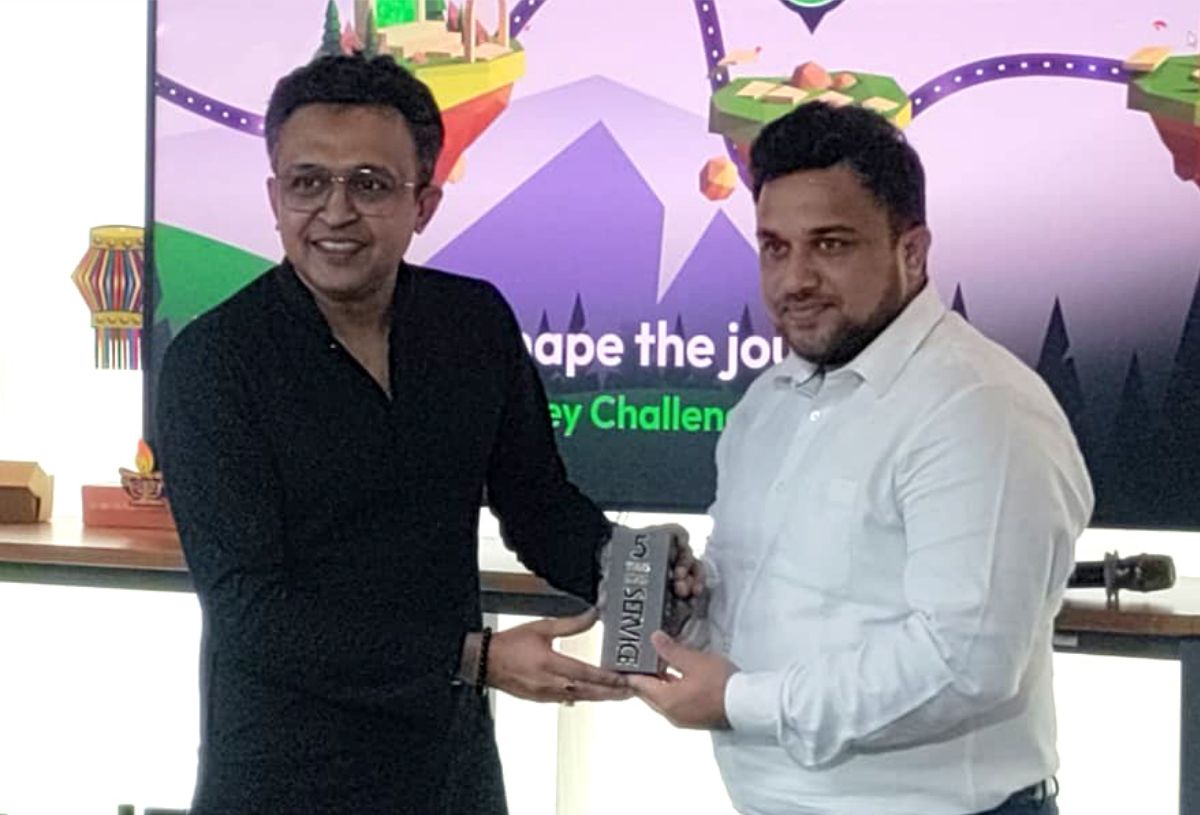How Employee Recognition Impacts Business Initiatives at Large Global Companies

Updated on
October 2, 2025
2
October
2025
Business on a global scale is more complex than ever. Large companies grapple with countless factors and challenges. The success of business initiatives depends not only on strategy and resources but also on the people behind them.
In other words, one of the best ways to improve business initiatives is closer and easier than you think—it starts with your own employees.
A structured employee recognition program has become an essential part of workplace culture at companies large and small around the world. Timely and personalized recognition leads to higher levels of engagement and better business outcomes.
When employees feel valued and appreciated, they feel like they belong. This sense of belonging helps form connection and a strong workplace community. This in turn leads to engaged employees who feel fulfilled and work harder with increased productivity.
It’s not exactly a science, but when you put all that together, recognition shows employees that you care and leads to growth and positive business outcomes.
Let’s look a little closer at how employee recognition at large companies impacts business initiatives. We’ll demonstrate why recognition is a powerful tool for improving engagement, fulfillment, and retention—all of which combine to significantly improve your company’s bottom line.

Employee engagement matters
Employee engagement is a foundational component of business outcomes. When it comes to wellbeing, good work, and performance, engagement sits at the center. To drive real change on your team, and to move the needle on the business metrics that matter, take time to learn about employee engagement in your organization.
While the Great Resignation may show signs of slowing, employee engagement is declining. According to Gallup: “After trending up in recent years, employee engagement in the U.S. saw its first annual decline in a decade—dropping from 36% engaged employees in 2020 to 34% in 2021.”
Gallup also found a decline in the number of employees who are satisfied with their organization as a place to work. There is a connection between employee engagement and job satisfaction that also affects business outcomes.
The good news is: While only 32% of U.S. employees overall were engaged in 2022, there are organizations that have more than doubled this percentage. Gallup’s 2022 Exceptional Workplace Award winners averaged 70% employee engagement even during highly disruptive times.
It’s no wonder that the companies that thrive, even during uncertain times, are the ones investing in their workplace culture. Recognition improves every aspect of community in the workplace. These organizations listen to employees and focus on the experience they have while at work. This people-centric model leads to consistent results and high engagement that keeps organizations ahead of the curve.
Engaged employees are the driving force behind successful business initiatives. Recognizing and appreciating employees' efforts creates a sense of belonging and loyalty, making them more invested in the company culture and goals.
Engaged employees are also more likely to proactively seek ways to contribute to the organization's success, take ownership of their responsibilities, and strive for excellence. They become brand ambassadors and advocates, promoting a positive image both internally and externally.
The fundamentals of employee fulfillment
As with many terms related to workplace culture, an idea like fulfillment is abstract and difficult to define, let alone measure. Despite that, we have learned quite a bit over the years. According to research from the O.C. Tanner Institute, highly fulfilled employees plan to stay three years longer at their organization than those who are unfulfilled.
The connections between fulfillment and business outcomes are compelling—employee fulfillment is a key indicator of employee morale and the production of great work. There are four concepts that lead to fulfillment:
- Community - belonging with a sense of purpose
- Opportunity - growth and the ability to demonstrate mastery
- Purpose - feeling like their work matters
- Balance - a measure of autonomy and flexibility
When employees rate all four areas high, they are 21 times more likely to be fulfilled. To help employees find fulfillment, organizations need to rethink how they support their people in each area.
For example, balance is not simply dividing time equally between work and personal activities. It’s often a sliding scale that changes based on the needs of the employee. When organizations create a culture where employees feel supported and empowered to balance their work and personal needs, they’re more likely to feel a greater sense of fulfillment in their jobs.

Similarly, to build a sense of connection and belonging at work, leaders must go beyond typical teambuilding activities to nurture a sense of inclusion and create a strong, supportive community within the organization’s larger culture—connecting employees regularly to purpose, accomplishment, and one another.
Organizations should also provide paths for employees to grow, even if pay increases and promotions are unavailable. Mentorship, tuition reimbursement, and special project assignments can all help employees master skills and feel that they’re making progress.
And finally, people can greatly expand the meaning they take from their work by connecting to the organization’s purpose. This requires leaders who consistently communicate it and help employees see how their work makes it possible.
Fulfillment also contributes to employee loyalty, which of course bolsters retention. Employee retention increases when people feel a sense of community and belonging, have opportunities to develop, are connected to purpose, and have flexibility in how, when, and where work gets done.

The benefits of retention
Employee retention can improve business outcomes in several ways:
1. Knowledge and Expertise
Retaining experienced employees allows a company to maintain valuable institutional knowledge and expertise. Experienced employees possess a deep understanding of the business processes, products, and services, which can contribute to increased efficiency, productivity, and innovation. This knowledge continuity avoids the need for constant retraining and helps maintain a competitive edge.
2. Cost Savings
High employee turnover can be expensive due to recruitment, onboarding, and training costs. By retaining employees, businesses can reduce these expenses and allocate resources more effectively. Moreover, long-term employees tend to become more productive over time, as they gain experience and become more proficient in their roles, thereby generating cost savings and higher output.
3. Employee Engagement and Productivity
Retained employees often exhibit higher levels of engagement and commitment to their work. When employees feel valued, supported, and recognized, they are more likely to be focused on achieving business goals. A workforce of recognized employees can lead to improved individual and team performance, higher quality work, and overall productivity gains.
4. Team Collaboration and Cohesion
Employee retention contributes to the development of strong team dynamics and collaboration. When team members work together for an extended period, they develop a better understanding of each other's strengths, weaknesses, and wor king styles. This familiarity and trust generate smoother communication, improved cooperation, and enhanced problem-solving capabilities, all of which positively impact business outcomes.
As the Harvard Business Review notes, “Recognition is fundamental to the engagement and retention of top talent and the profitability of our organizations.” Research shows that “employees who reported that their managers were great at recognizing them were more than 40% more engaged than those with managers who were not. In addition, they were more confident, felt better informed, offered more discretionary effort, and were less likely to quit.”

Global recognition solutions with a local touch
At O.C. Tanner, we offer a wide range of capabilities for organizations looking to enhance their employee appreciation experience. You want your recognition program to be in sync with other company objectives.
For example, if you are expanding globally, you’ll want to ensure your recognition platform supports multiple languages and aligns with local practices.
Our forms of recognition and tools are structured for global scale and seamless integration with the largest companies and large workforces. Here are a few ways in which we accomplish that:
1. Awards and Recognition
O.C. Tanner provides a comprehensive selection of awards, including trophies, plaques, certificates, and personalized gifts. These types of recognition can be customized to reflect the organization's brand and values, making them meaningful and memorable for recipients.
2. Global Network
We have a vast global network that allows us to serve organizations in multiple countries. With local expertise and resources in various regions worldwide, we ensure that solutions are culturally relevant and aligned with local practices.
3. Innovative Platforms
We offer advanced technology platforms to facilitate employee recognition and engagement. These platforms are designed to be user-friendly and scalable, allowing organizations to manage their recognition programs from the smallest branch to their largest global needs. The platforms incorporate features like social recognition, peer-to-peer recognition, and analytics for tracking program effectiveness.
4. Multi-Language Support
Recognizing the importance of employee recognition and authentic communication, we provide multi-language support in our solutions. This enables organizations to implement recognition programs in different languages, catering to the needs of their global workforce.
5. Global Rewards and Experiences
We offer a diverse range of global rewards and experiences that can be included in recognition programs. These rewards may include travel experiences, unique adventures, gift cards, and more. We collaborate with local partners worldwide to ensure access to a wide array of options, accommodating various cultural preferences, customs, and traditions.
6. Program Design and Strategy
We assist organizations in designing and implementing effective recognition program strategies. We provide consultation services to help align recognition efforts with the organization's goals, values, and desired outcomes. We also offer training and resources to help organizations thrive in a culture of recognition.
7. Data and Analytics
Our platforms provide robust data and analytics capabilities. Organizations can track and measure the impact of their recognition programs, gain insights into employee engagement, and identify areas for improvement. This data-driven approach enables organizations to make informed decisions and optimize their employee recognition initiatives.

Recognize employees to improve business initiatives
Implementing an employee recognition program is a highly effective strategy for improving metrics across all business outcomes. By acknowledging and rewarding employees' efforts, organizations can cultivate a positive work culture, enhance employee engagement, and drive productivity.
The benefits of an integrated employee recognition program have a ripple effect, leading to improved employee engagement, a greater sense of fulfillment, and strong retention. Furthermore, recognizing and appreciating employees' contributions not only boosts individual performance but also promotes teamwork and collaboration, resulting in better overall organizational performance.
Ultimately, a successful employee recognition program demonstrates a commitment to valuing and investing in your people. And it's a true win-win situation. Your employees feel happier at work and your business is rewarded with enhanced business outcomes across the board.
If you’d like to talk to the employee recognition experts at O.C. Tanner about how we can help craft a solution for you, please reach out to us.



